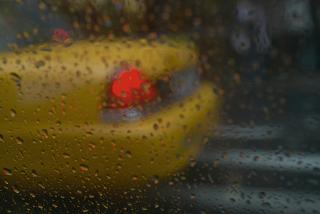If you missed part I of this post, feel free to check it out here.
Only Smooth Moves:
Turning a motorcycle on such a slick surface demands an ultra-smooth approach. Getting on the brakes abruptly or making a sudden steering input could put you in the guardrail. So you want to be slowed down before you go in there and keep the throttle neutral all the way through –and be ready for cars that might get unstuck and block the whole mess.
That smooth approach to speed and direction changes will serve you well on all wet roads. Initiate your turns a bit more gradually. Downshift smoothly, engaging the clutch a bit slower than usual, and avoid abrupt throttle changes. Get on the throttle progressively. Use a taller gear to reduce the forces reaching the rear tire. Apply the brakes in such a way that the tires are not loaded abruptly. Allow more space to stop or slow down so that you need less. And also make sure that drivers around you have time to react to your moves.
The Eyes Need It: Though it might look better at the end of a long ride in the wet, a black rainsuit is going to be very hard to see in heavy rain.
**Image to the left taken from Motorcycle Superstore website.
That brings us back to vision. The ability of other drivers to see us could be the single biggest issue a motorcyclist must confront in the rain. With low light, windows obscured, and a streaked and possibly fogged windshield, the driver of a car may have a very difficult time seeing the world ahead. If you are wearing black, or even worse, a neutral color like gray or olive drab, you blend into that gray world. A bright yellow rainsuit is probably the best choice and the single simplest way to make your wet-weather rides safer, though white is also an excellent choice and even better than yellow at night. Fluorescent colors also help during the day and retro-reflective striping or panels on your rainsuit, helmet or a pack also help at night. A visible helmet color also makes a difference at night.
How about your own ability to see? Even with a faceshield that’s wet on both sides, you probably have a better view of the situation around you than the average car operator does in the rain. The drops on a faceshield (or goggles) are inside your focal point and are just vague blurs when you focus on the road ahead. However, your view can be impaired by faceshield fogging or a windshield that rises into your line of sight. Unlike a faceshield, a windshield is well out in your focal range, and the water on both sides makes it hard to see through. Rain-X does help disperse water on both face- and, more importantly, windshields.
Anti-fogging solutions and the Fog City Fog Shield effectively stop fogging, although the Fog Shield is not recommended for use at night because it creates some ghost images. Even if you don’t have a commercial anti-fog solution, a thin layer of hand or dish soap will stop fog. You can wipe it on wet or dry, than polish it off.
A Rainy Night:
For many motorcyclists, the demons come out on a rainy night. Each of those raindrops on your faceshield or goggles picks up a pinpoint of light from every light around you. Riding behind a windshield that is too tall to see over is extremely difficult, which is why we caution against that configuration. Oncoming cars can completely obscure your vision. A timely wipe of your faceshield can help, but you may be unable to see the road at all for a moment. Puddles may be completely undetectable.
On the other hand, lights that aren’t so bright — such as taillights — reflected in the road surface ahead can show you features of the road surface that you headlight doesn’t illuminate. My preferred strategy is to follow (at a distance that keeps me out of its spray) a vehicle with lots of taillights, watching the point where they are reflected to pick out potholes, seams, or objects lying in the road. Watching the vehicle will also warn you of large puddles, which could cause hydroplaning if you hit them fast enough.
Even at night a motorcyclist has a few aces to play. One advantage of a motorcycle is your high view point compared a person in a car. At night, this allows you a better view of the road surface because you have a steeper angle of view. As a result, it’s easier to see striping, and other shallow features. You can also use the reflective qualities of wet surfaces to your advantage. Wet utility wires or tree branches can warn you of a car approaching over a hill or around a corner. Brake lights reflected under a truck can alert you of an impending stop.
Did you find these bad weather motorcycle safety tips helpful? We’d love to hear from you in our comments section.
As a Charleston SC motorcycle injury attorney, I’m pleased to present a guest video post from the highly acclaimed Charleston tax attorney, Evan Lacke. Evan was kind enough to provide us with a video on why we, as motorcyclists, need to have our estate documents in place.
See below for the video:
Learn more about Evan here, or connect with him on Facebook.


